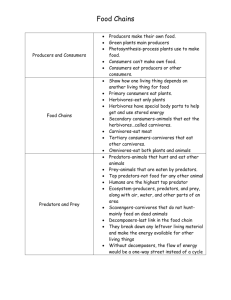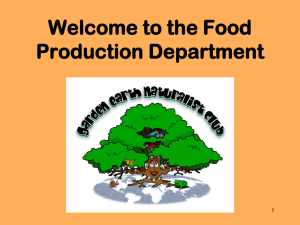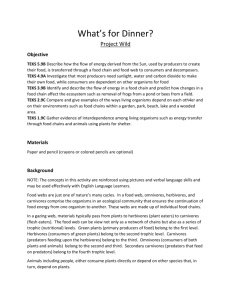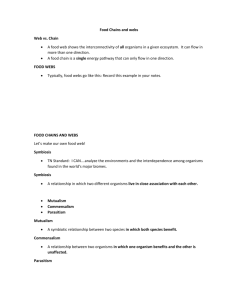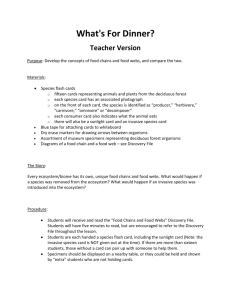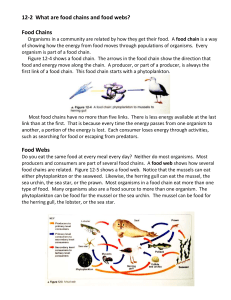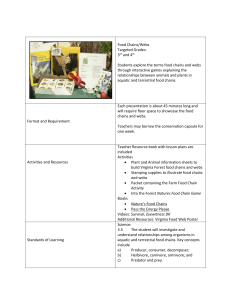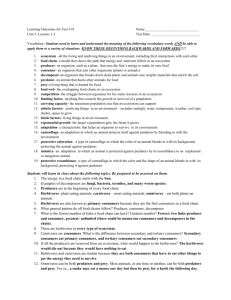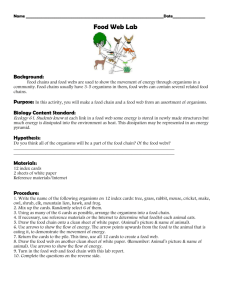5-2.4 - S2TEM Centers SC
advertisement
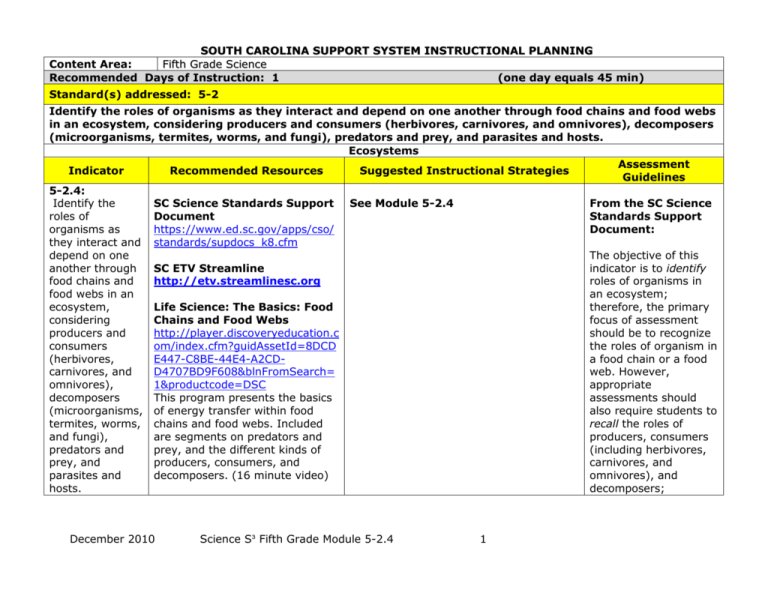
SOUTH CAROLINA SUPPORT SYSTEM INSTRUCTIONAL PLANNING Content Area: Fifth Grade Science Recommended Days of Instruction: 1 (one day equals 45 min) Standard(s) addressed: 5-2 Identify the roles of organisms as they interact and depend on one another through food chains and food webs in an ecosystem, considering producers and consumers (herbivores, carnivores, and omnivores), decomposers (microorganisms, termites, worms, and fungi), predators and prey, and parasites and hosts. Ecosystems Assessment Indicator Recommended Resources Suggested Instructional Strategies Guidelines 5-2.4: Identify the SC Science Standards Support See Module 5-2.4 From the SC Science roles of Document Standards Support organisms as https://www.ed.sc.gov/apps/cso/ Document: they interact and standards/supdocs_k8.cfm depend on one The objective of this another through SC ETV Streamline indicator is to identify food chains and http://etv.streamlinesc.org roles of organisms in food webs in an an ecosystem; ecosystem, Life Science: The Basics: Food therefore, the primary considering Chains and Food Webs focus of assessment producers and http://player.discoveryeducation.c should be to recognize consumers om/index.cfm?guidAssetId=8DCD the roles of organism in (herbivores, E447-C8BE-44E4-A2CDa food chain or a food carnivores, and D4707BD9F608&blnFromSearch= web. However, omnivores), 1&productcode=DSC appropriate decomposers This program presents the basics assessments should (microorganisms, of energy transfer within food also require students to termites, worms, chains and food webs. Included recall the roles of and fungi), are segments on predators and producers, consumers predators and prey, and the different kinds of (including herbivores, prey, and producers, consumers, and carnivores, and parasites and decomposers. (16 minute video) omnivores), and hosts. decomposers; December 2010 Science S³ Fifth Grade Module 5-2.4 1 Food Chains and Webs http://player.discoveryeducation.c om/index.cfm?guidAssetId=E32E 5847-B736-420B-B2AA60A811AF158B&blnFromSearch= 1&productcode=DSC Take a tour of the food chain and an expedition with Dr. Brian Jerome to examine how energy and matter are transferred through the environment. Students will learn about food chains and webs by studying the interactions of the various species of plants and animals. (21 min.) recognize from drawings or diagrams the components of a food chain or food web; or recognize the roles of predators and prey as well as parasites and host. Brainpop Video- “Food Chains” http://www.brainpop.com/science /ecologyandbehavior/foodchains/ Learn about Food Chains Freshwater: National Geographic http://environment.nationalgeogr aphic.com/environment/habitats/f reshwater-profile/ Explore freshwater ecosystems and habitats FOSS Web: http://www.fossweb.com/module sMS/PopulationsandEcosystems/in dex.html December 2010 Science S³ Fifth Grade Module 5-2.4 2 American Museum of Natural History website. http://www.amnh.org/nationalcen ter/online_field_journal/index.htm l Children can explore the wonders of nature from the American Museum of Natural History Website “Create a Food Chain” Science Graphic Organizers and MiniLessons by Maria L. Chang http://www.amazon.com/reader/ 0439548969?_encoding=UTF8&pa ge=49#reader_0439548969 MC Biology http://www.marietta.edu/~biol/1 02/ecosystem.html Ecosystems Environmental Protection Agency http://www.epa.gov/bioindicators /aquatic/index.html Contains information about aquatic biodiversity and ecosystems Cool Science for Curious Kids http://www.hhmi.org/coolscience/ forkids/inchsquare/index.html December 2010 Science S³ Fifth Grade Module 5-2.4 3 Fifth Grade Science Module 5-2.4 Food Chains and Food Webs Lesson A Standard 5-2: Students will demonstrate an understanding of relationships among biotic and abiotic factors within terrestrial and aquatic ecosystems. (Life Science) Indicator 5-2.4 Identify the roles of organisms as they interact and depend on one another through food chains and food webs in an ecosystem, considering producers and consumers (herbivores, carnivores, and omnivores), decomposers (microorganisms, termites, worms, and fungi), predators and prey, and parasites and hosts. December 2010 Science S³ Fifth Grade Module 5-2.4 4 From the South Carolina Science Support Documents: Indicator 5-2.4: Identify the roles of organisms as they interact and depend on one another through food chains and food webs in an ecosystem, considering producers and consumers (herbivores, carnivores, and omnivores), decomposers (microorganisms, termites, worms, and fungi), predators and prey, and parasites and hosts. Taxonomy level: Remember Conceptual Knowledge (1.1-B) Previous/Future knowledge: In 3rd grade (3-2.5), students summarized the organization of simple food chains (including the roles of producers, consumers, and decomposers). In 7th grade (7-4.2), students will illustrate the flow of energy in food chains, food webs and energy pyramids. It is essential for students to know that all organisms need energy to live and grow. This energy is obtained from food. The role an organism serves in an ecosystem can be described by the way in which it gets its energy. Producers Plants are called producers because they are able to use light energy from the Sun to produce food (sugar) from carbon dioxide in the air and water. Consumers Animals cannot make their own food so they must eat plants and/or other animals. They are called consumers. There are three main groups of consumers. o Animals that eat only plants are called herbivores. o Animals that eat only animals are called carnivores. o Animals that eat both animals and plants are called omnivores. Decomposers Consumers (including microorganisms, termites, worms, and fungi) that get the energy they need by breaking down dead or decaying matter. These decomposers speed up the decaying process that releases nutrients back into the food chain for use by plants. One way to show how energy is passed through an ecosystem is through a food chain. A food chain is a series of plants and animals in which each organism is a source of food (energy) for the next in the series. In a typical food chain, plants use the Sun’s energy to make their own food and then are eaten by one kind of animal which in turn is eaten by another kind of animal. Most organisms are part of more than one food chain and eat more than one kind of food in order to meet their energy requirements. Interconnected food chains form a food web. Most food chains have no more than six organisms. December 2010 Science S³ Fifth Grade Module 5-2.4 5 There cannot be too many links in a single food chain because the animals at the end of the chain would not get enough food (energy) to stay alive. The role of an organism can be identified by its placement on the food chain. Decomposers are not typically noted on a food chain; they will break down any organism on the food chain when it dies. An example of a grassland food chain: Sun Grass Grasshopper Toad Snake Hawk → → → → → → Producer Consumer Consumers Note that the arrows are drawn from food source to food consumer Organisms can also be identified based on how they interact with other organisms. Predators are animals that hunt and kill other animals for food. Prey are animals that are hunted and killed as food for other animals. A parasite is an organism that spends a significant portion of its life in or on a living host organism usually causing harm to the host without immediately killing it. Hosts are organisms or cells that serve as a home or a source of food for a parasite. It is not essential for students to identify trophic levels found in a food chain or web, identify energy pyramids, or know other relationships between organisms (such as mutualism, commensalism, or symbiosis). Assessment Guidelines: The objective of this indicator is to identify roles of organisms in an ecosystem; therefore, the primary focus of assessment should be to recognize the roles of organism in a food chain or a food web. However, appropriate assessments should also require students to recall the roles of producers, consumers (including herbivores, carnivores, and omnivores), and decomposers; recognize from drawings or diagrams the components of a food chain or food web; or recognize the roles of predators and prey as well as parasites and host. December 2010 Science S³ Fifth Grade Module 5-2.4 6 Teaching Indicator 5-2.4: Lesson A: “Am I the Predator or Am I the Prey?” Instructional Considerations: This lesson is an example of how a teacher might address the intent of this indicator. Misconceptions: Lower elementary-school students can understand simple food links involving two organisms. Yet they often think of organisms as independent of each other but dependent on people to supply them with food and shelter. Upper elementaryschool students may not believe food is a scarce resource in ecosystems, thinking that organisms can change their food at will due to the availability of particular sources. Students of all ages think that some populations of organisms are numerous in order to fulfill a demand for food by another population. Safety Note: Students should follow all classroom safety procedures. Lesson time: 1 Days (1 day equals 45 minutes) Materials Needed: Large index cards String to attach name tags Hole punch Markers Large open space to do lesson Focus Question: What are the components of food chains and food webs? Engage: 1. Begin by asking students questions that will lead their thoughts to basic relationships within the ecosystem. Start by making the lesson personal. Ask the students about what they need to survive, and what kinds of things they eat. Then relate that information to animals in nature. a. What did you eat for breakfast this morning? (Cereal, toast, eggs, etc.) b. Where did you find that food? How did it get there? (In the cabinet, refrigerator, etc. Mom or Dad bought it.) c. Did you have anything to drink with breakfast? (Water, juice, etc.) d. Where did you eat breakfast? (At the house, in the kitchen) e. Imagine now, that you were a baby squirrel, and it was time for breakfast. What would you eat and drink? December 2010 Science S³ Fifth Grade Module 5-2.4 7 (Nuts, human scraps, milk from my mother, maybe water) f. Where did you get the food? How did it get to you? (From trees in the forest, Mother or Father brought it to you.) 2. Continue asking the students questions that will allow them to draw conclusions and form relationships. What things did you find you needed to survive the morning, that are the same as the baby squirrel. (food, water, protection/home/shelter, and a space for that home) 3. What is the importance of these things? (Surviving, and living) You may then want to ask more questions about the significance of shelter as protection from predators. Explore: 1. This is essentially a game of tag, but one in which students will gain an appreciation of ecology, food webs, and predator-prey relationships. The food chains (within the food web) should be constructed to be appropriate for organisms in your area. This will enhance the students’ understanding of their own ecosystem. It is best played outside or in a gym. 2. Create nametags (example on page 10) for participating “organisms” using large colored index cards. The nametags should reflect organisms involved in an actual food pyramid, and allow each student to play. An example food chain might be: Hawks-squirrels-fish-flies-grasshoppers. 3. Write on each nametag, in large print, the name of each animal (Predator) the student will represent. Under that animal, in smaller print and in a different color, write the names of the animals which may be eaten (prey) by the predator. (Writing the names of the prey is optional, and you may choose to exclude it for older students) Be sure that only a few students represent the animals at the top of the food chain, such as 6 hawks, and that there are larger groups of students representing the animals at the lower end of the food chain, such as grasshoppers and flies. Randomly give each student a nametag; students “become” that animal. Explain that they are only allowed to tag (hunt/kill) the food that they would take as prey. 4. Once outside, each animal group has a specific “safe site” that represents their shelter, this might be a tree or a corner of a building, and when the student is touching that tree or building, they are safe in their “shelter”. The last student (or students) standing are the best hunters or winners. December 2010 Science S³ Fifth Grade Module 5-2.4 8 Explain: 1. Students collaborate with partners to answer the following using resources if necessary. Which animals were the carnivores and herbivores? Which animals were the producers and consumers? What represented each animal’s habitat, and what would constitute an ideal habitat for that animal? Which animals were the predators; which were prey? How did energy transfer in the food web? Using the game as an example, define an individual, population, and community. What is a niche? What is the niche of the predator, of the prey? How were populations regulated? 2. Have each group summarize and share what is necessary for an organism’s survival. Extend: 1. Think Pair Share: Divide the class into pairs or small groups. Have students work together to brain storm food chains and fill in their graphic organizer (found on page 13 or “Create a Food Chain” Science Graphic Organizers and Mini-Lessons by Maria L. Chang http://www.amazon.com/reader/0439548969?_encoding=UTF8&page=49#read er_0439548969) When students are finished, invite volunteers to share their food chains with the rest of the class. 2. View the SCETV Streamline clip: The Basics: Food Chains and Food Webs http://player.discoveryeducation.com/index.cfm?guidAssetId=8DCDE447-C8BE44E4-A2CD-D4707BD9F608&blnFromSearch=1&productcode=DSC This program presents the basics of energy transfer within food chains and food webs. Included are segments on predators and prey, and the different kinds of producers, consumers, and decomposers. (16 minute video) 3. View the SCETV Streamline clip: Food Chains and Webs http://player.discoveryeducation.com/index.cfm?guidAssetId=E32E5847-B736420B-B2AA-60A811AF158B&blnFromSearch=1&productcode=DSC Take your students on a tour of the food chain. Come along on an expedition with Dr. Brian Jerome to examine how energy and matter are transferred through the environment. Students will learn about food chains and webs by studying the interactions of the various species of plants and animals. (21 minute video) December 2010 Science S³ Fifth Grade Module 5-2.4 9 Example Name tag for Lesson 1 – Eco-Tag (Predator) Hawk (Prey) Squirrels Fish Mice December 2010 Science S³ Fifth Grade Module 5-2.4 10 Food Chain Create a food chain by writing or drawing a series of organism that depend on one another for food. December 2010 Science S³ Fifth Grade Module 5-2.4 11
